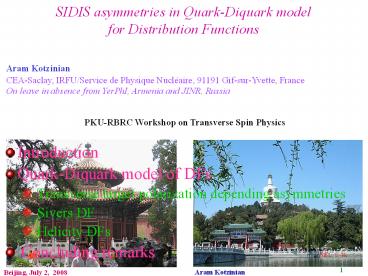SIDIS asymmetries in QuarkDiquark model for Distribution Functions - PowerPoint PPT Presentation
Title:
SIDIS asymmetries in QuarkDiquark model for Distribution Functions
Description:
CEA-Saclay, IRFU/Service de Physique Nucl aire, 91191 Gif-sur ... Why changing form-factor of nucleon-quark-diquark vertex brings to unphysical kT behavior? ... – PowerPoint PPT presentation
Number of Views:39
Avg rating:3.0/5.0
Title: SIDIS asymmetries in QuarkDiquark model for Distribution Functions
1
SIDIS asymmetries in Quark-Diquark model for
Distribution Functions
Aram Kotzinian CEA-Saclay, IRFU/Service de
Physique Nucléaire, 91191 Gif-sur-Yvette, France
On leave in absence from YerPhI, Armenia and
JINR, Russia
PKU-RBRC Workshop on Transverse Spin Physics
- Introduction
- Quark-Diquark model of DFs
- Transverse target polarization depending
asymmetries - Sivers DF
- Helicity DFs
- Concluding remarks
2
General expression for 1h production cross-section
This is a general expression which is also valid
for exclusive reactions and for entire phase
space of SIDIS (TFR, CFR) Azimuthal
modulations 2 polarization independent 1 single
beam polarization dependent 2 single target
longitudinal polarization dependent 1 double beam
target longitudinal polarization dependent 5
single target transverse polarization dependent 3
double beam target transverse polarization
dependent
A.K. NPB 441 (1995) 234 Bacchetta et al, JHEP
0702093,2007
3
Measured Structure Functions and Asymmetries
4
Twist-two TMD quark DFs
DFs from Q-DQ model
5
Twist-two TMD quark FFs
FFs from DSS and Anselmino et al parameterisations
6
Quark-Diquark model for DFs
R. Jakob, P. Mulders Rodrigues NP A626, 937
(1997)
Choose exponential form-factor
k, m
MR, Rs,a
Only few common parameters, mq0.36, MA0.8,
MS0.6, ?0.5 (GeV/c), for all DFs No x-kT
factorization and width of intrinsic transverse
momentum depends on x
7
Quark-Diquark model, 2
Proton SU(6) wave function
And same for other DFs
Sivers and Boer-Mulders DFs are equal to zero
8
Interpretation of target transverse spin
asymmetries
8 Structure Functions for target transverse spin
part
Parton model, Twist-2
Sivers
Collins
Comparison with x-dependence of COMPASS Deuteron
target data Nucl.Phys.B76531,2007
arXiv0705.2402 arXiv0709.3440
9
Sivers asymmetry
Further comments later
10
Collins asymmetry _at_
COMPASS
11
Collins asymmetry _at_
HERMES
We expect that Q-DQ model will work in the
valence quark region
12
and
_at_ COMPASS
13
Cahn kinematical corrections
14
Interpretation of target transverse spin
asymmetries
Twist-2 DFs and FFs kT/Q kinematical
corrections
Works
Doesnt work
15
and _at_
COMPASS
16
and _at_
COMPASS
17
Sivers effect
J.Ellis, D-S.Hwang, A.K. preliminary Sivers
function a la BHS from FSI
18
Sivers effect 2
HERMES Proton target
as0.3
19
Analyzing power of Sivers functions Positivity
Bound
Consider large kT limit
Brodsky, Hwang Schmidt
20
Analyzing power of Sivers functions, 2
JMR model (dipole formfactor), J.Ellis,
D-S.Hwang, A.K.
21
Analyzing power of Sivers functions, 3
Gaussian form-factor (J.Ellis, D.Hwang, A.K.)
Transverse Quark Spin Effects and the Flavor
Dependence of the Boer-Mulders Function L.Gamberg,
G.Goldstein M.Schlegel, 0708.0324v2
22
Quark longitudinal polarization
For given x the sign of the polarization is
changing at high kT
23
Quark longitudinal polarization
For given x the sign of the polarization is
changing at high kT
24
Orbital momentum and g1L
Model by Brodsky, Hwang, Ma Schmidt, NPB 593
(2001) 311
25
Positive and negative helicity DFs in Q-DQ model
26
ALL _at_ JLab
Duak-Diquak model
M.Anselmino, A.Efremov, A.K B.Parsamyan PRD
74, 074015 (2006)
The case
is
very similar to Quark-Diquark model results
27
HERMES, Vaness Mexner PhD (2005)
28
Concluding remarks
- JMR q-dq model is a good tool for guidance
- The kT and pT dependences of (polarized) DFs and
FFs can be nontrivial. - No x-kT factorization in DFs, flavor dependence
of kT(x), pT(z) - The kT dependence of DF g1 is tightly related to
quark orbital momentum - In valence region this model is able to describe
the x-dependence of new 6 transverse spin
dependent azimuthal asymmetries - Do we understand well dynamical origin of Sivers
effect? - FSI?
- Why changing form-factor of nucleon-quark-diquark
vertex brings to unphysical kT behavior? - How one can resolve this problem?
- Twist-four?
- More measurements are needed for better
understanding TMD DFs - HERMES 6 asymmetries transversely polarized
proton target? - For better understanding of SIDIS we need the
data for unpolarized x-sections and asymmetries
(Rh(x,z,pT), ALL(pT)) as a function of all
kinematical variables (x, z, PT, Q2) or (x, PT)
, (z, PT), (xF, PT)
29
Additional slides
30
cos(f) asymmetry in Q-DQ model (Cahn effect)
31
cos(2f) asymmetry in Q-DQ model (Cahn effect)
32
cos(2f) asymmetry in Q-DQ model (Cahn effect) 2
Different kT width for S and A form-factors
33
Subleading twist
34
Higher twist example 2 predictions for cos(fs)
asymmetry
Spectator model
Cahn correction for g1T contribution

